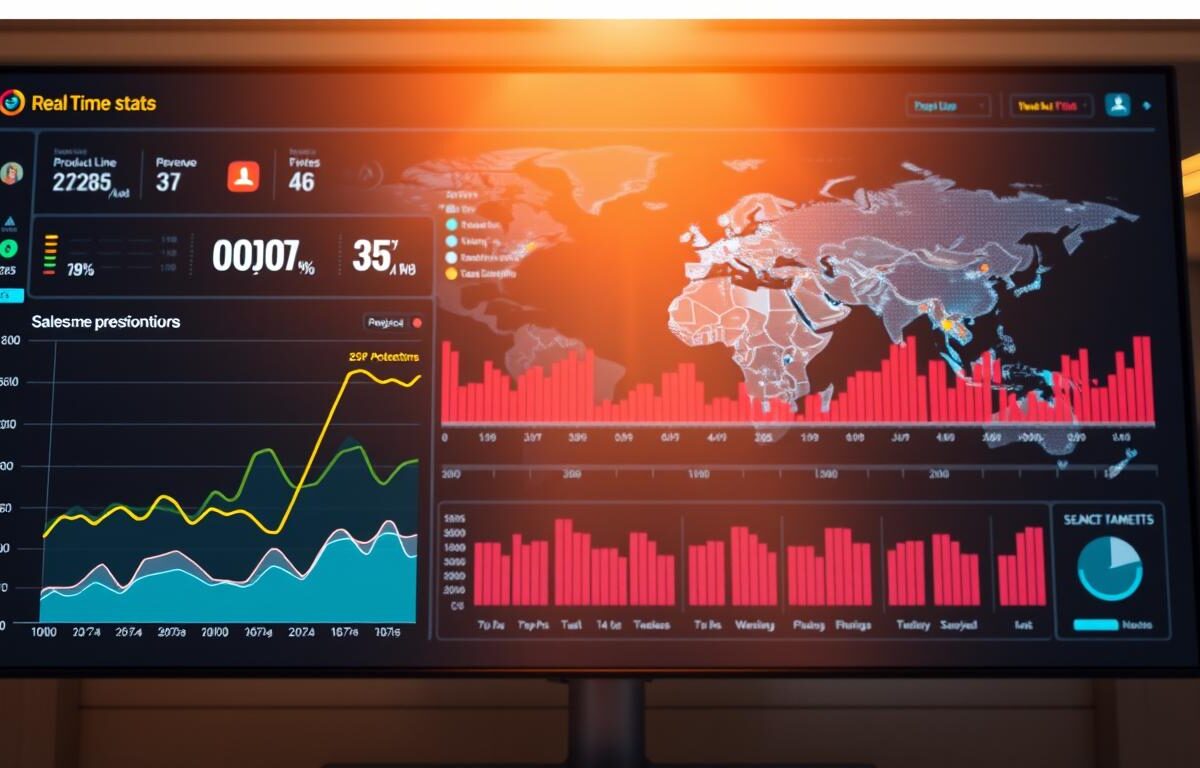In our fast-moving business world, GTM automation is key. It turns sales forecasting into something much smoother and faster. By embracing tech for this, companies get more precise and quick, cutting down mistakes. With big data changing how we plan in the market, using GTM tools is becoming crucial. These tools help sales people focus on big goals, helping the company grow and make more money. This article looks into how GTM automation makes sales forecasting better and how it gives companies an edge.
Key Takeaways
- GTM automation makes sales forecasting way more efficient.
- Using automated tools means fewer mistakes and less need for people to check things.
- Being more accurate with forecasts helps with making smarter plans.
- Big data pushes forward new and better ways to forecast sales.
- With automation, the sales team can focus on the most important tasks.
- Putting GTM automation in place can really help increase how much money a company makes.
Understanding GTM Automation and Its Importance
GTM automation boosts sales strategies and product delivery with advanced tech. It’s crucial in today’s competitive world, helping businesses align with market needs and smooth out operations. It lets businesses refine sales forecasting and gain deep insights into their sales activities.
Definition of GTM Automation
GTM automation uses tech to improve market entry and sales management processes. It integrates CRM tools, artificial intelligence, and data analysis. By focusing on these areas, companies unlock key sales automation benefits that increase productivity and forecasting accuracy.
Key Components of GTM Automation
Effective GTM automation is built on several important elements. These include:
- CRM integrations for unified customer data.
- Artificial intelligence for predictive analytics and insights.
- Data analysis tools for understanding markets and customer behavior.
These elements save time on manual tasks, shifting focus to core profit-building activities. This automation is vital for optimizing sales forecasting.
Benefits of GTM Automation for Sales Forecasting
GTM automation offers many benefits. It makes forecasting more accurate, helping predict sales trends better. These advantages don’t stop at forecasting; they make operations efficient, smooth customer interactions, and heighten satisfaction. For more on these benefits, check out this in-depth article about how GTM automation transforms business.
The Role of Data in GTM Automation
Data is key for improving sales forecasting with automation. It comes from different places and really shapes business plans. It’s important to understand where data comes from and use the right tools to make better sales forecasts and business decisions.
Data Sources for Accurate Forecasting
To get good sales forecasts, companies need to look at many data sources, such as:
- Customer interactions, which provide insights into purchasing behaviors.
- Market trends that highlight evolving consumer preferences.
- Historical sales performance data that offers a benchmark for future expectations.
This mix of sources helps teams understand customer habits and market changes better. This leads to more accurate forecasts.
Data Management Tools and Techniques
Good data management makes sales forecasting automation more efficient. CRM systems and analytics software are key tools in this area. These tools help businesses:
- Assess potential leads efficiently, optimizing marketing efforts.
- Utilize AI-driven insights to enable predictive analytics.
- Access real-time market data and trends for informed strategic decision making.

Using various data sources and effective tools streamline sales forecasting. This prepares organizations to deal with market changes well. For more on improving forecasting through automation, check out this guide.
Effective Tools for GTM Automation
Businesses looking to boost their sales forecasting should use a variety of automated gtm tools. The choice of the right gtm automation system can greatly enhance sales. There are many software options, each with special benefits for different needs. Here we’ll look at top tools and compare their features to help companies choose wisely.
Overview of Leading GTM Automation Software
Top tools include Salesforce, HubSpot, and ZoomInfo. Each platform has special strengths for sales teams who want to automate their market approaches. Salesforce is great for CRM, while HubSpot is easy to use for marketing and sales. ZoomInfo is strong in lead generation with its detailed data solutions. Knowing what each offers can help businesses use their features for better sales.
Comparing Features of Popular Tools
| Software | Key Features | Ease of Integration | Pricing |
|---|---|---|---|
| Salesforce | Advanced CRM, analytics, customizable dashboards | High | Varies by subscription |
| HubSpot | Inbound marketing tools, sales automation | Very high | Freemium model with upgrades |
| ZoomInfo | Comprehensive B2B data, lead scoring | Moderate | Premium pricing |
When looking at these gtm tools, companies must consider their unique features, costs, and how well they integrate. A thorough comparison helps leaders find the best gtm automation platform for their business needs.
Implementing GTM Automation in Your Business
Implementing GTM automation for better sales forecasting needs a good plan and steady steps. It’s key to set clear goals for a successful automation of sales. This sets the base for picking the right tools that meet your business needs.
Planning how to integrate and train your team is crucial for a soft shift to automated systems.
Steps to Get Started with GTM Automation
Follow these important steps to boost sales forecasting:
- Identify specific business objectives related to forecasting.
- Research and select automation tools that fit organizational requirements.
- Create a detailed integration plan that includes timelines and resource allocation.
- Train team members comprehensively on the selected tools and processes.
- Establish ongoing support and review mechanisms to adapt the system as necessary.
Common Pitfalls to Avoid
Avoid these common mistakes to secure success:
- Neglecting data quality can lead to inaccurate forecasts.
- Overlooking the need for continual adjustments makes the system less effective.
- Failing to foster a culture that embraces automation may create resistance among staff.
By tackling these challenges head-on, firms can better their sales forecasting. Adopting GTM automation offers a competitive edge in today’s market. For more advice, consider looking into expert resources for practical strategies.

Forecasting Techniques Enhanced by Automation
Today, advanced forecasting methods like time series analysis and machine learning are changing sales forecasting automation. These techniques use past data and algorithms to give businesses accurate predictions. This helps to strengthen their sales strategies.
Time Series Analysis
Time series analysis is crucial for gtm forecasting solutions. It looks into past sales data to find seasonal trends and patterns. This helps organizations predict future sales better and reduce uncertainties.
By analyzing patterns, companies can understand customer buying habits better. This way, they can adapt quicker to market changes.
Machine Learning in Sales Forecasting
Machine learning greatly impacts sales forecasting automation. It analyzes large data sets with its algorithms to create up-to-date forecasting models. These models get better with each new piece of data, keeping businesses ahead.
By using machine learning, companies get better at quickly responding to market shifts. This improves inventory control and strategic planning.
By combining *time series analysis* and *machine learning*, businesses can boost their forecasting. This leads to better sales and strategic choices. For more details on AI in sales forecasting, see this article.
Measuring the Success of GTM Automation
To measure GTM automation’s effectiveness, you need to look at certain key performance indicators (KPIs) that are tied to sales forecasting. By examining these metrics, businesses can grasp how automation influences their sales activities and results.
Key Performance Indicators (KPIs)
For a clear view of sales forecasting automation’s impact, companies should track several KPIs such as:
- Forecast Accuracy: This metric checks if the actual sales numbers match the predicted ones.
- Lead Conversion Rates: This looks at the success in turning leads into genuine sales.
- Sales Productivity: This measures how well the sales team meets their goals efficiently.
- Time to Close: By observing how long sales take to close, we can see how automation makes processes smoother.
Evaluating Forecast Accuracy
It’s vital to regularly check forecast accuracy to tweak GTM strategies accordingly. When organizations spot differences between their forecasts and real sales, they can make the right changes. These insights allow companies to enhance sales effectiveness and improve customer experiences and overall performance.
In summary, using KPIs for sales automation boosts understanding of business performance and helps in making smarter decisions.
| KPI | Description | Importance |
|---|---|---|
| Forecast Accuracy | Compares the accuracy of sales forecasts to actual sales. | Essential for strategic decisions and allocating resources. |
| Lead Conversion Rate | Shows the percentage of leads turning into sales. | Reflects the effectiveness of the sales team and marketing efforts. |
| Sales Productivity | Looks at sales made by each employee or how quickly deals are closed. | Points out operational strengths and areas needing improvement. |
| Time to Close | Gives the average time to finish a deal. | Provides insights into how efficient the process is and the role of automation. |
Future Trends in GTM Automation and Sales Forecasting
The field of sales forecasting is changing fast, thanks to new tech. The use of GTM automation to make sales forecasting seamless is key for businesses wanting better forecast accuracy and speed. Trends in AI for sales automation are set to change how companies grasp market dynamics and predict what customers want.
Advanced Technologies Shaping the Future
As we look to the future, AI and machine learning are expected to lead in sales forecasting technology. These tools will help companies use predictive analytics to get insights in real-time. This way, they can quickly respond to market shifts and consumer habits. Thanks to these technologies, making choices based on data will be easier and more exact.
Predictions for the Next Five Years
In the next five years, analysts believe companies with advanced automation and AI will lead over others in efficiency and connecting with customers. Those that adopt these technologies will create new standards in sales forecasting. Making sure GTM automation integrates well for smooth sales forecasting will be key to getting ahead.
| Trend | Description | Impact on Sales Forecasting |
|---|---|---|
| AI Integration | Utilizing artificial intelligence to enhance forecasting accuracy. | Increased precision and responsiveness to market fluctuations. |
| Predictive Analytics | Employing data to forecast future sales trends. | Empowers proactive decision-making based on real-time data. |
| Automation of Processes | Streamlining sales processes through automation tools. | Improved efficiency and reduction of human errors. |
| Big Data Analytics | Analyzing large datasets for comprehensive market insights. | Facilitates better understanding of customer behaviors and trends. |
Case Studies of Successful GTM Automation
The world of GTM sales forecasting has changed a lot thanks to automation. Businesses from different sectors like B2B SaaS, manufacturing, and retail have seen big benefits. One SaaS company, for example, made their data analysis much faster. This not only got them better forecasts but also let them react quicker to changes in the market.
Looking at how different companies use GTM automation teaches us valuable lessons. One major takeaway is the importance of choosing the right tech. For a big retail company, the move to a better sales automation system showed how crucial training is. It made sure everyone could use the new tech well. Also, fitting the automation into what the company already did helped keep things running smoothly.
These stories give hints on how to improve GTM automation. They show the importance of the right technology, preparing your team, and integrating new systems smoothly. Learning from the wins and hurdles of others sheds light on how to do it right. This knowledge can help businesses boost their forecasting and performance.
FAQ
What is GTM Automation?
GTM Automation means using tech to make getting products to market easier. It includes CRM tools, AI, and data analysis. These tools help make sales forecasts better and more accurate.
How can GTM Automation improve sales forecasting accuracy?
It cuts down on mistakes by using lots of data and AI. With machine learning, sales predictions get more precise. This helps businesses make smarter decisions.
What are the key benefits of implementing GTM sales forecasting automation?
Main advantages are saving time on manual work and getting more accurate sales forecasts. It also boosts team work and helps give customers a better experience. In a competitive market, offering the best customer service is key.
What are some leading software solutions for GTM Automation?
Top GTM software includes Salesforce, HubSpot, and ZoomInfo. They offer CRM tools, automation, and analytics. These are important for making sales forecasting smoother.
What steps should be taken to implement GTM Automation effectively?
Start by setting clear goals and picking the right tools. Plan how to blend them into your work and train your team to use them. Keeping data accurate and being open to new tech are also important.
How should companies measure the success of their GTM automation efforts?
They should watch things like how accurate forecasts are, and if they’re selling more. Checking these helps tweak strategies and see how well GTM tools are working.
What future trends should be considered in GTM Automation and sales forecasting?
Expect more use of AI, machine learning, and big data. These will greatly help in making fast adaptations to market changes. Staying ahead in forecasting is crucial.
Can you provide examples of industries benefitting from GTM Automation?
Industries like B2B SaaS, manufacturing, and retail are using GTM tools well. They show how picking and applying the right tech can enhance forecasts and efficiency.



